In 2014 Thales made the Capella MBSE workbench open source in the Eclipse Foundation with the help of Obeo. At that time, Capella was successfully deployed across various Thales Business Units worldwide. The objective to make Capella open source was to extend its adoption by allowing other organizations to use it.
In 2021, with more than 450 identified organizations using Capella, almost 50 organizations officially stating it on the Capella Adopters page, and 850+ attendees from 50+ countries at Capella Days 2020, it seems that we have reached the goal to make Capella a reference solution, used worldwide in multiple and various domains.
Animating a community and growing such an ecosystem requires a better knowledge of the profile of its members, the way they are using the workbench, and their expectations about MBSE in general. This is the reason why we launched a Community Survey by the end of 2020.
This survey was composed of 21 questions in 3 sections addressed to Capella users:
- About you and your company
- About Capella in your organization
- About MBSE adoption in your company
The survey was open for 3 months, from 28th of October 2020 to 28th of January 2021, and we received 52 actionable answers.
Users profile
Coming from 16 different countries, almost one in two respondents are from Defense (18,6%), Aeronautics (16,9%), and Space Systems (12,7%). One in five come from services or research domains. And from the five other sectors, 3 represent transportation domains: Automotive (7,6%), Naval (5,9%) and Railway (5,1%).
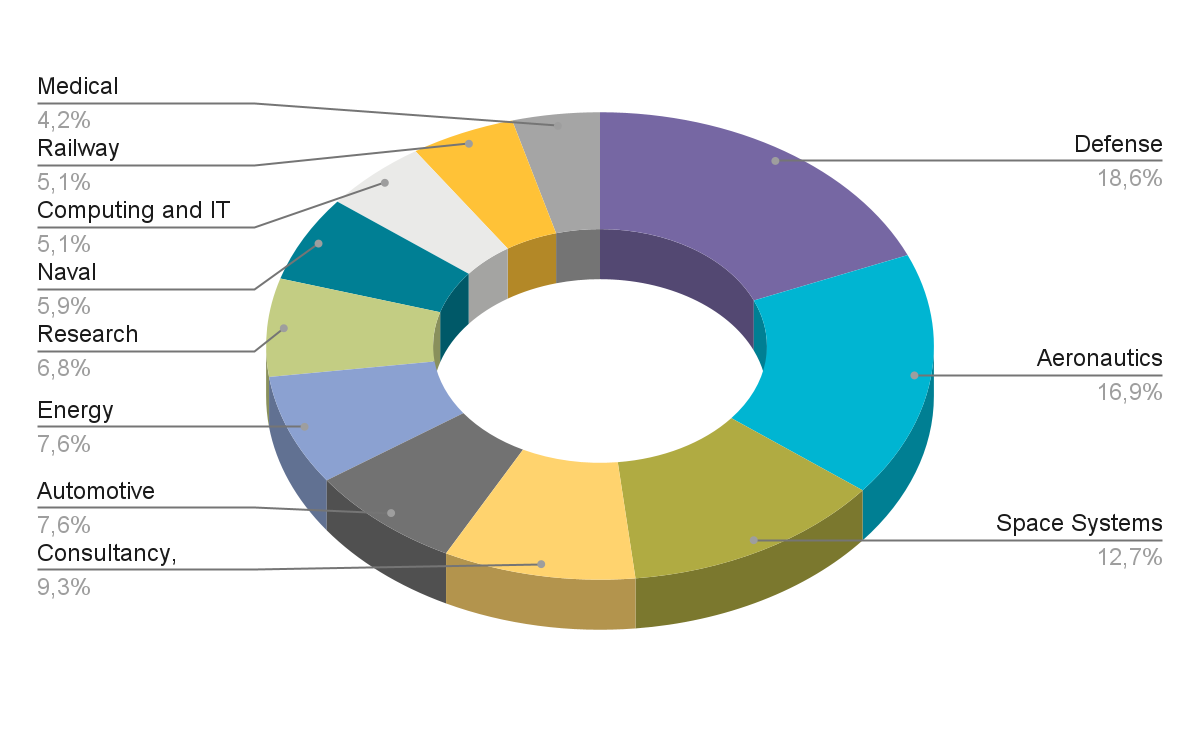
For an overwhelming majority, respondents are working for large companies: 74% in companies with at least 250 employees, and 35% in companies with more than 5000 employees.
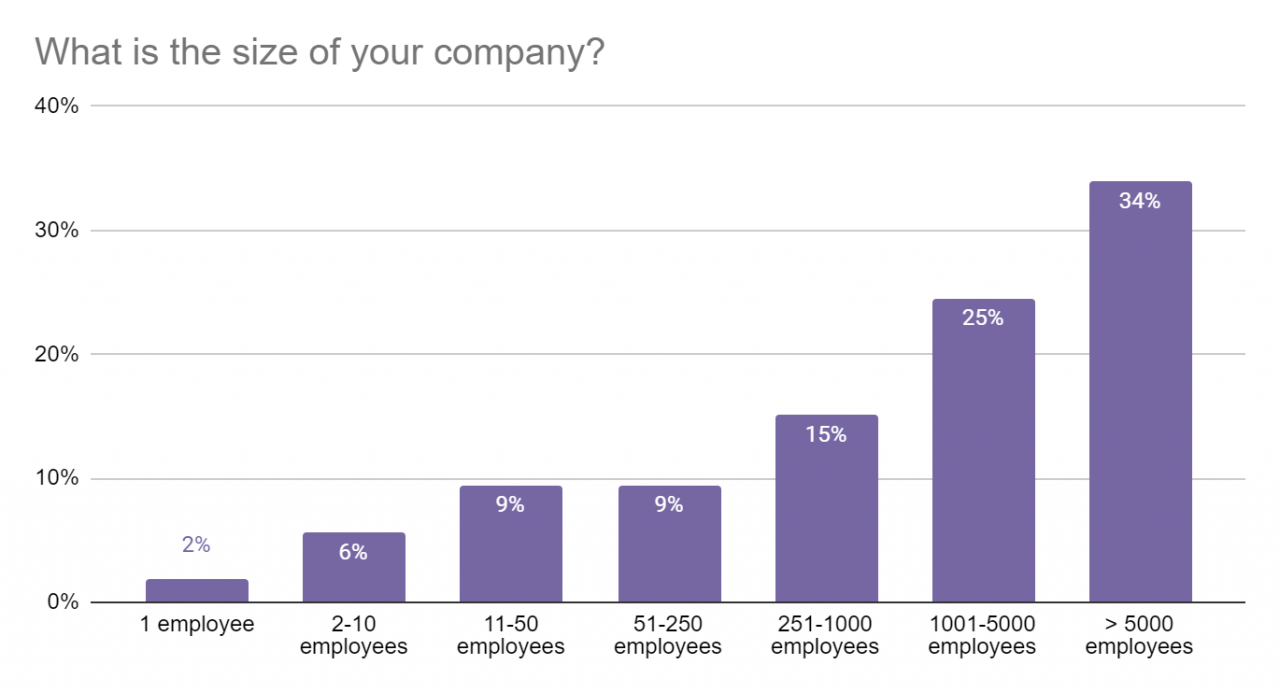
Mostly, respondents have a strong experience in MBSE (any methodologies and tools): 58% have been already working with MBSE for more than 3 years.
Adoption of the MBSE approach
To obtain a better vision of how and why Capella adopters are using the MBSE approach in their organization, we asked questions about the implemented MBSE capabilities, the adoption factors and the expected benefits. For this section, we proposed criteria inspired by the MBSE Maturity Survey published by the Systems Engineering Research Center (SERC) in March 2020. This study was itself based on the INCOSE Model-Based Enterprise Capability Matrix.
First, we wanted to know which capabilities were implemented in the enterprise, and what were the challenges, enablers, and organizational changes that were required to implement them.
We proposed 10 capabilities out of the 35 studied in the SERC article:

5 of them, was considered implemented (agree, or strongly agree) by at least 50% of the respondents:
- Mature process/tool strategies (59%)
- Models are the basis for technical processes (59%)
- Have clearly defined roles supporting MBSE (56%)
- MBSE is the basis for Technical Review (56%)
- Mature model management process (53%)
The least implemented capability is “Have consistent metrics across enterprise” (31%).
This is a very important difference with the results observed in the SERC Study, where only one of the same capabilities (“Support model libraries for model reuse”) collected a majority of agreement about its implementation in the organization of respondents.
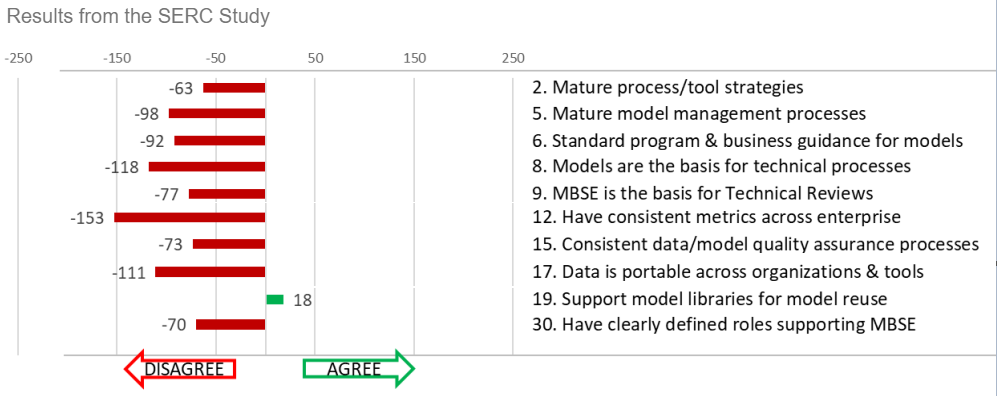
Capability Maturity Scorecard from the SERC Study (extract)
This may indicate a stronger maturity regarding these MBSE criteria by Capella users, and hence a successful implementation of these processes. This could be partially explained by the fact that by using Capella, users also implement Arcadia, the field-proven MBSE method embedded in the workbench.
To understand which factors were playing a (positive or negative) role in the implementation of an MBSE approach, we proposed to evaluate 10 factors (out of 37 studied by the SERC).
6 of these factors were considered as enablers by more than 50% of respondents:
- Champions (76%)
- Leadership support/commitment (71%)
- Alignment with customer requirements (68%)
- Demonstrating benefits/results (63%)
- Cost to use MBSE tools (55%)

It highlights that successfully implementing an MBSE approach requires engaging in concrete operational projects and setting up a specific organization that enables methodological support and coaching (with champions), which implies the support of the management.
The approach must rapidly deliver concrete and measurable results, aligned with customers' expectations. The Arcadia method embedded in Capella clearly drives users to make explicit the customers’ expectations and how the system architectures fulfill them.
And the cost of the tools required to implement the approach is also an important factor. Capella is open-source and ready to use in standalone mode. This, and the cost of the collaborative version of Capella (Team for Capella), are enablers for success for Capella users.
In our study, we wanted to evaluate the difference between the initial expectations about MBSE and the reached objectives.
The good news, very few of all the expected objectives have completely failed.
More precisely, the main expected objectives are mostly considered completely or partially reached.
- Improved system understanding (56% Yes, observed or partially, 4% No, too soon to know or failed)
- Increased traceability (52% vs 16%)
- Better analysis capability (56% vs 12%)
- Better manage complexity (40% vs 4%)
- Improved consistency (44% vs 4%)
- Better requirements management (36% vs 12%)
- Improved collaboration (36% vs 20%)
- Better communication/info sharing (40% vs 8%)
One major expected objectives has a mixed result:
- Improved system quality (32% vs 32%)
Some objectives, that were not considered as a priority, have clearly not been reached. But respondents mostly consider that it’s too early to give a definitive judgment:
- Improved risk analysis (16% vs 32%)
- Increased productivity (20% vs 28%)
- Improved predictive ability (8% vs 28%)
- Increased capacity of reuse (12% vs 28%)
- Increased flexibility (12% vs 24%)
- Higher level of support for integration (8% vs 28%)
- Early V&V (8% vs 28%)
Note that some of these objectives could be addressed by Capella when complemented by tools specialized in configuration management (reuse) and verification.
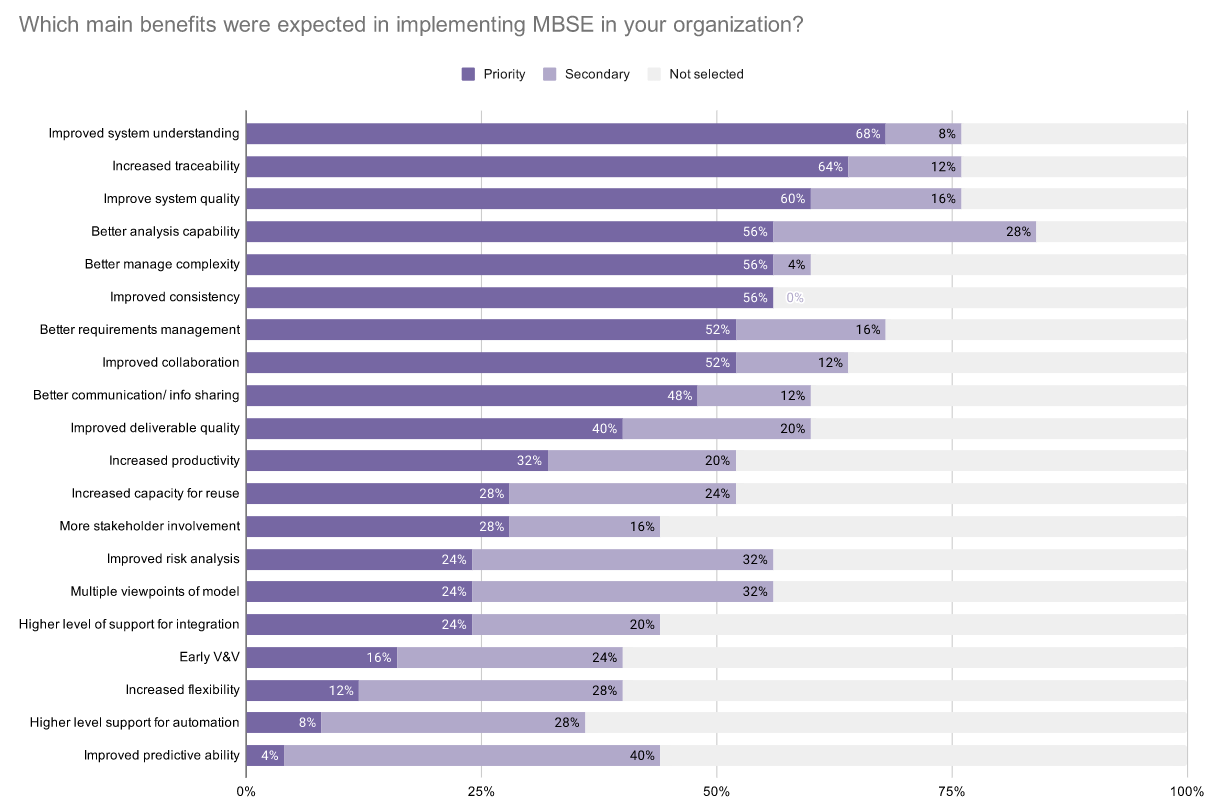
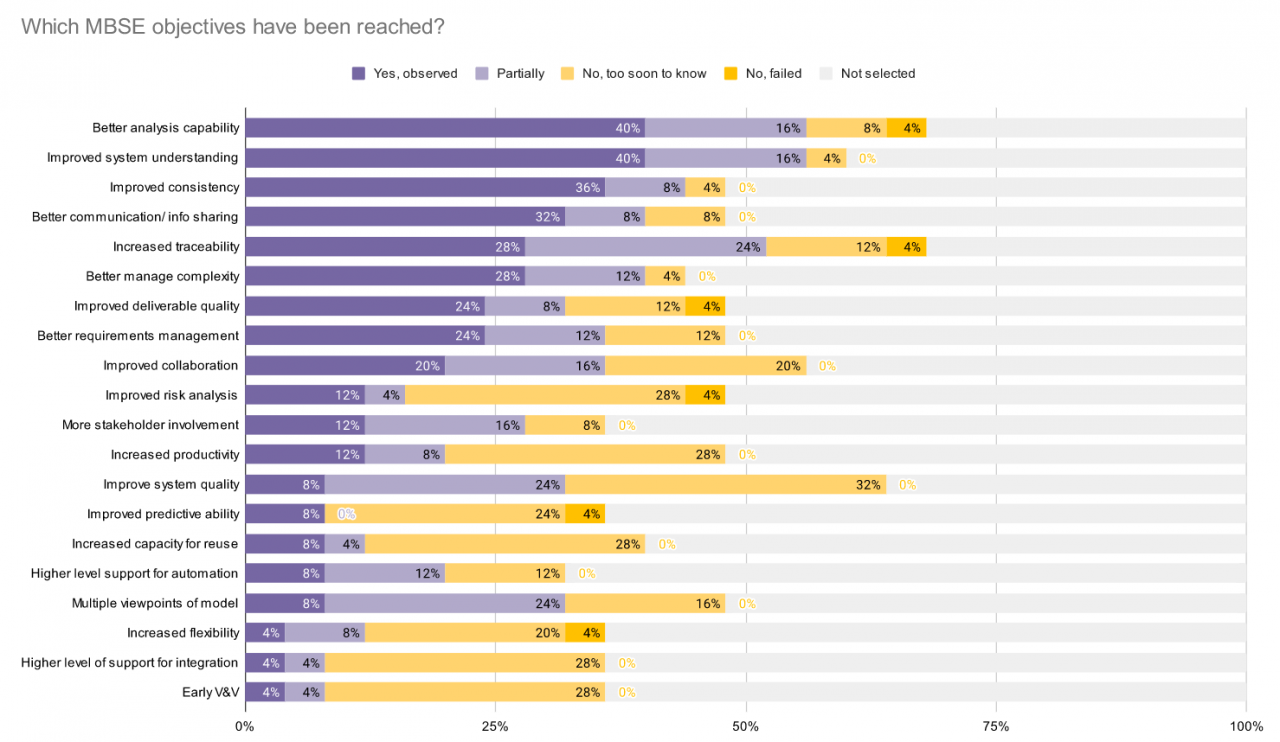
Finally, we asked what was the main success factor for reaching these benefits, among the MBSE approach in general, the Arcadia method, and the Capella tool.
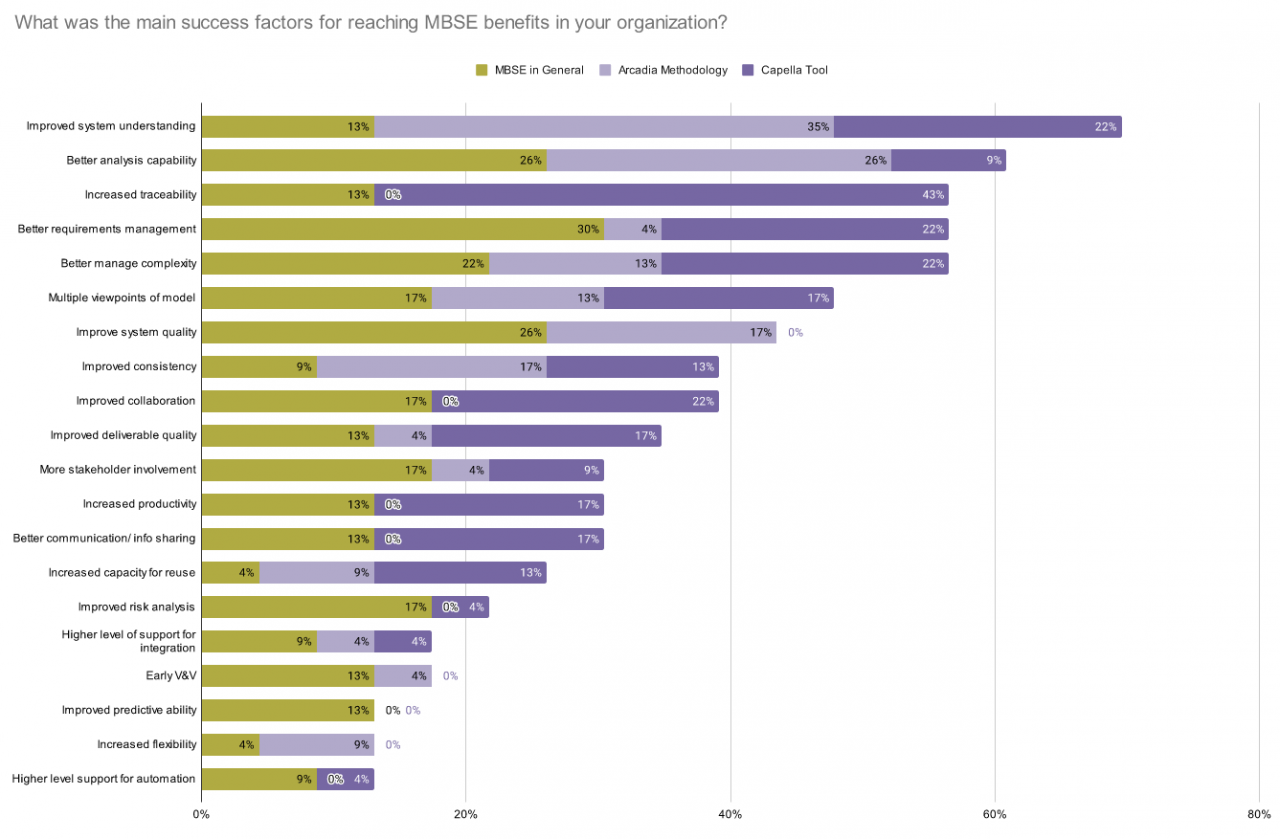
If we only select the factors selected by at least 20% of respondents, we find that the Arcadia method is designated for the most expected objective:
- Improved system understanding (35%).
The Arcadia method is also selected for the 4th expected objective:
- Better analysis capability (26%, tied with the MBSE approach).
In addition to this objective, the MBSE approach is also a success factor for three main objectives:
- Better requirement management (30%,7th priority expected benefit)
- Improve system quality (26%, 3rd priority expected benefit)
- Better manage complexity (22%, tied with Capella tool, 5th priority expected benefit)
Regarding the Capella tool, almost one respondent out of two (43%) select it as the main success factor for the 2nd priority expected benefit:
- Increased traceability
It gathers 22% for four other objectives :
- Improved system understanding (1st priority expected benefit)
- Better manage complexity (5th)
- Better requirement management (7th)
- Improved collaboration (8th)
If we group the Arcadia method and the Capella tool, which are closely related, we find that combined they pass 20% for two other objectives :
- Multiple viewpoint of models (30%)
- Improved consistency (30%)
These results highlight the key role that an engineering method plays in successfully implementing MBSE, especially in complex systems and large organizations contexts. Capella embeds the Arcadia method, which has proven its elasticity when adopted in several industrial domains, very different from the ones of the Thales Group. Capella and Arcadia are an excellent jumping-off point once you decide to implement MBSE in your organization.
Usage of Capella
Another part of the survey was related to the Capella tool itself and its usage in the organization of respondents.
The Arcadia viewpoint-driven method implemented in Capella provides several perspectives.
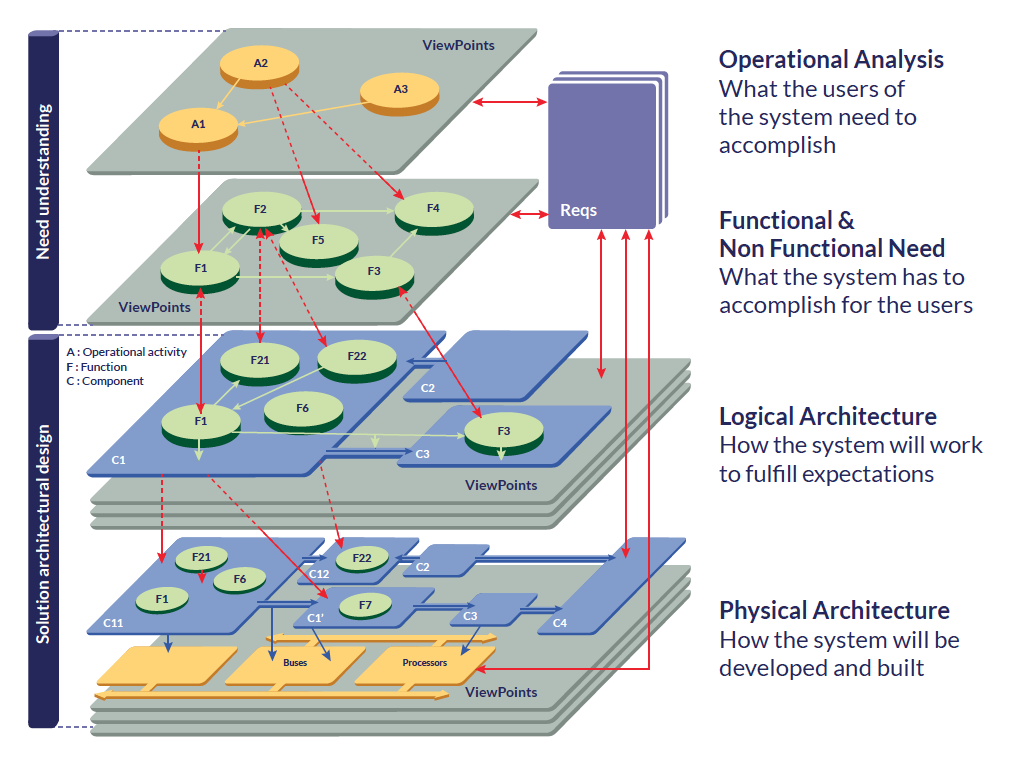
Among these perspectives, the most used are System Analysis (what functions the product has to accomplish for the users), Logical Architecture (how the product has to accomplish for the users), and Physical Architecture (how the system will be developed and built). Most of the respondents also use the Operational Analysis (what the user of the product needs to accomplish), but a little less often. Finally, one perspective is much less used: the End-Product Breakdown Structure (a summary of the component integration contract) with only 35%.
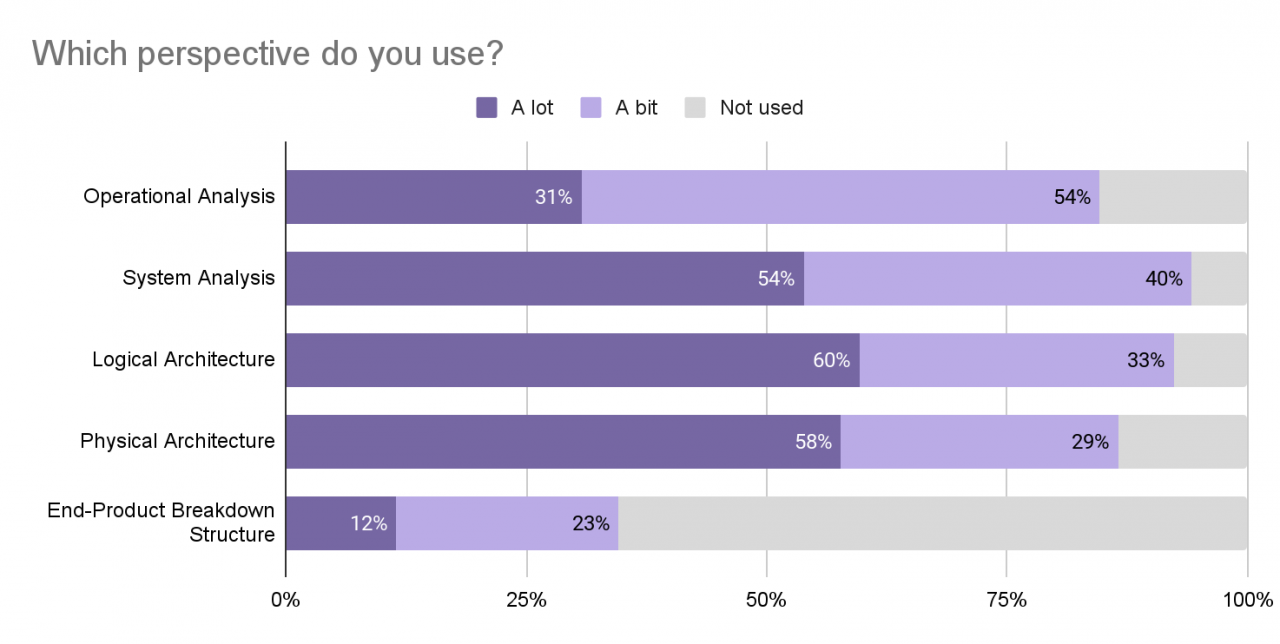
An interesting finding related to the respondents who are using “A lot” the “Operational Analysis” is that 80% of them are also using “A lot” the “System Analysis”, and 68% are also using “A lot” the “Logical Architecture”. This may confirm the value of Operational Analysis is on very complex systems or even systems-of-systems, in which users often define high-level conceptual architectures that are refined later at sub-systems levels.
Regarding the representations, i.e. the ways the model can be represented visually, the Architecture diagrams are widely used (96%, including 81% using a lot). Four other representations are used a lot by almost one respondent on two: Functional Chains, Data Flows, Scenarios (Sequence diagrams), and Capabilities diagrams. The last four representations are Modes & States, Trees, Classes & Interfaces, and Tables. Even if they are less used, they remain used by at least 63% of respondents (almost 2 on 3). This may indicate that all the representations provided by Capella are useful somehow.
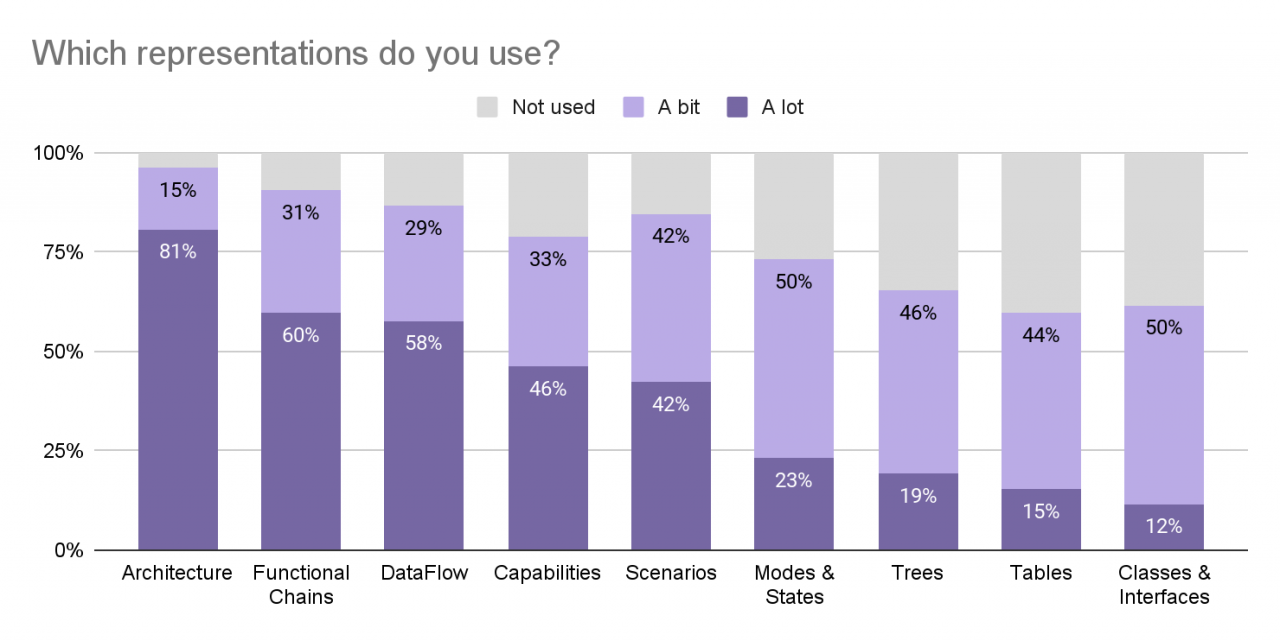
In addition to representations, Capella offers advanced features to help the user to create consistent models, navigate through elements, analyze the architecture, etc. The two features considered as the most important ones are Methodological Guidance (a browser that provides an entry point to the engineering activities defined by the Arcadia method) and Simplification of Diagrams (the possibility to display computed links for hiding low-level links, to filter a diagram to mask some information, etc). The third voted feature is the Semantic Browser (a view that dynamically shows the incoming and outgoing relations to and from a selected model element). This only highlights the benefits of having a method (Arcadia) embedded in the tool (Capella), and a tool that makes possible an efficient deployment of a method.
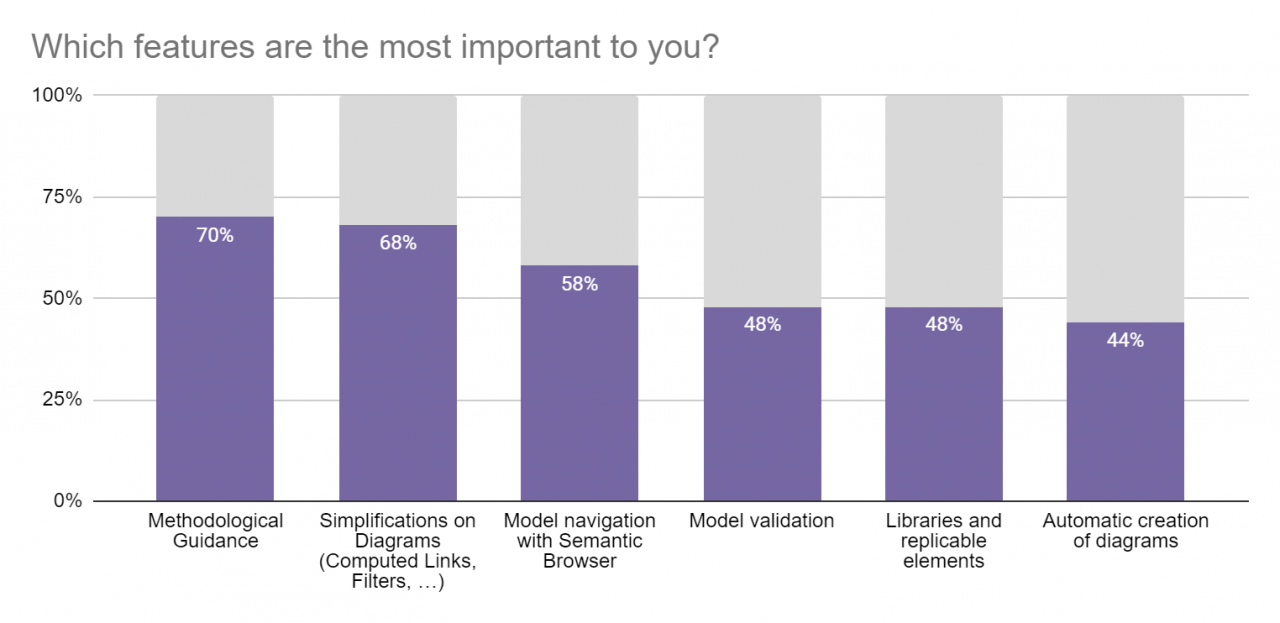
The usage of add-ons to Capella has been considered separately depending on open-source or commercial licenses. A large majority of respondents (58%) use the open-source add-on Requirements Viewpoint which allows establishing traceability links between textual requirements and the system elements. This is not surprising as MBSE approaches are generally mixed with traditional systems engineering which is based on textual requirements.
Behind this add-on, three other open-source add-ons are used by at least 40% of respondents :
- System to Subsystem Transition: enables to manage several levels of engineering by initializing a new project from a Capella model
- XHTML Documentation Generation: automatically produces an HTML website from a Capella project
- Property Values Management Tools (PVMT): allows end-users to easily define and value their own specific properties on Capella model elements
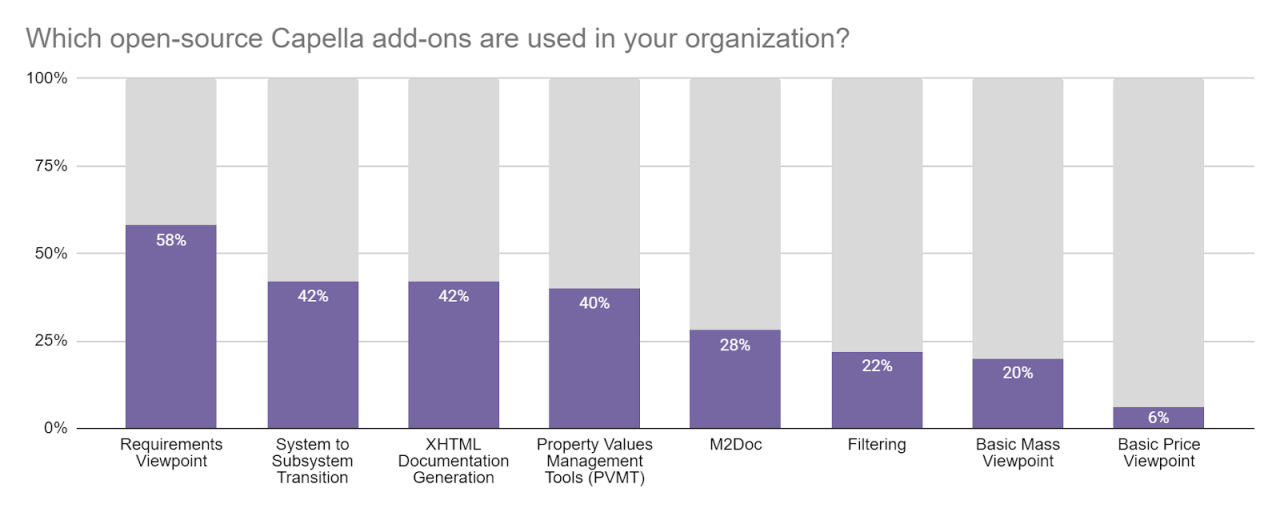
By counting the number of open-source add-ons declared by the respondents, we can see that the usage of add-ons is widely spread: 85% of them use at least two add-ons, and a third (31%) use at least 4 add-ons.
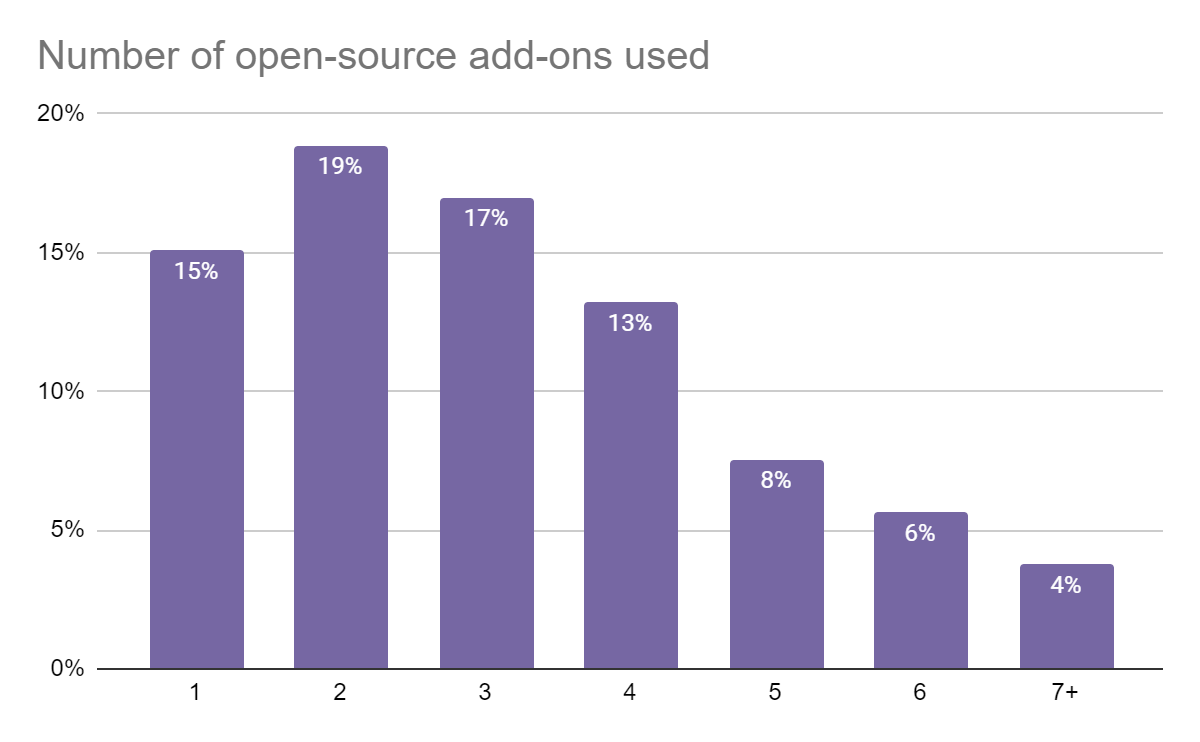
With price and download barriers to entry, commercial add-ons have a smaller diffusion, indicating that Capella users can rely on the open-source offer on their projects. Nevertheless, three add-ons overtop with at least 10% of adoption:
- Team for Capella (by Thales, commercialized by Obeo): enables to simultaneously edit a Capella model shared on a server.
- System Modeling Workbench (SMW) for Teamcenter (by Siemens and Obeo): an integration of Capella with the Siemens’ PLM solution.
- RAT - Authoring Tools (by The Reuse Company): assists users when writing requirements statements
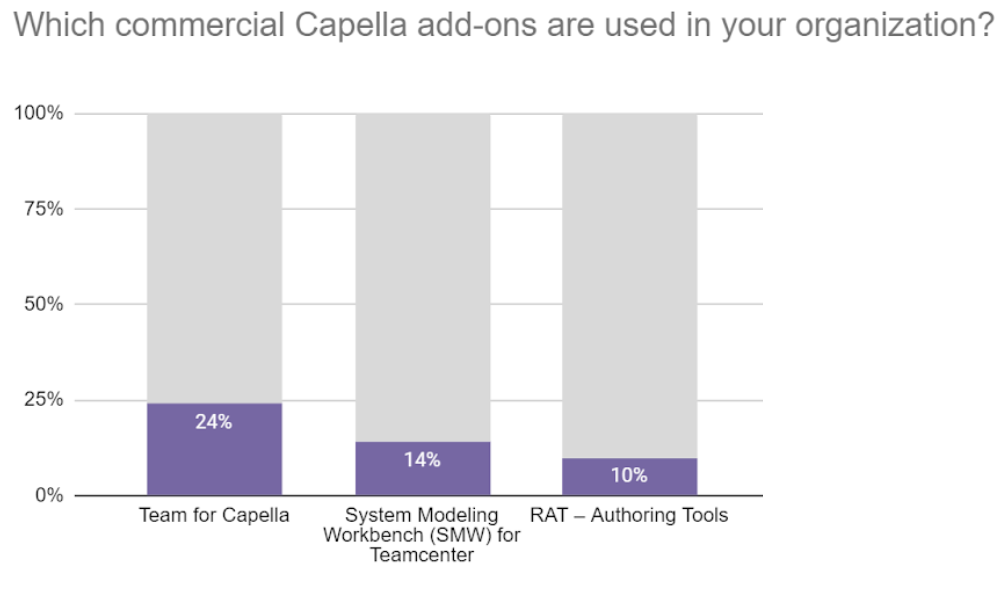
If we compare the usage of commercial add-ons with the MBSE maturity of respondents, we can see that they are used by almost one in two respondents (43% and 44%) using MBSE for at least three years.

Most of the add-ons, being open-source or commercial, are installed manually and individually by Capella users on the default Capella distribution available on the project website (75%). At least one in four respondents rely on a more industrial way, by delegating this integration to an internal team or to a software provider which provides them with a specific Capella distribution (configured with pre-defined options and a selected and integrated set of pre-installed add-ons).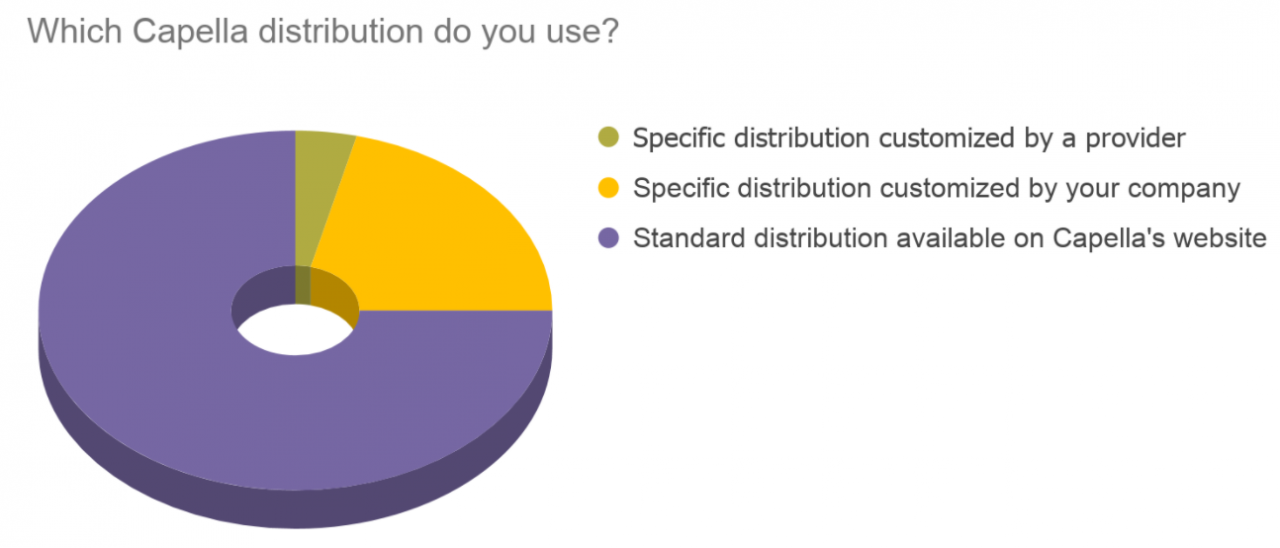
Conclusions
This survey gives us an interesting picture of the Capella community. In particular, although this survey is not as extensive as the one produced by SERC, it shows some notable differences about MBSE maturity. Respondents of our survey seem to have a stronger maturity in the MBSE approach, with more implemented processes.
These differences can be explained by two main reasons. The first one is that deploying a tool across teams requires aligning the practices between members in order to produce gains (what to model, when, why, … ?). Without such alignment, sharing models is difficult and MBSE practices remain mainly individual. It means that organizations that have effectively deployed a tool, have necessarily defined processes, which is a quite good indicator of maturity.
The other reason is related to Capella itself. Indeed, Capella is not just an MBSE tool. It implements Arcadia, a field-proven MBSE method that guides the systems engineers by providing well-defined concepts and viewpoints. It is a clear accelerator to deploy effective processes and to ramp up a consistent adoption within an organization.
This survey was the first of its kind in the Capella Community. We expect to renew this study in the upcoming months and measure how the results evolve. Stay tuned! And in the meantime, we’re counting on you to help us in the development of this vibrant community: show your adoption on the adopters' page, or present your case studies and solutions to events such as Capella Webinars or Capella Days.
